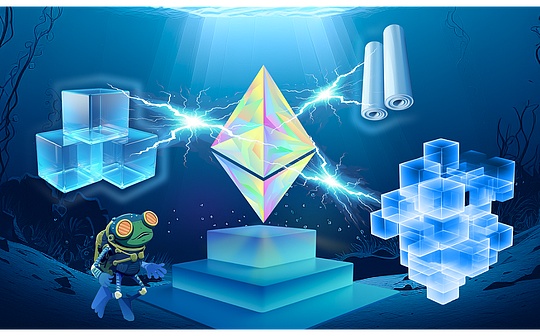
Recently, Crypto exchange Bybit released a report stating that BTC will continue to outperform other markets in 2024, and it is expected that the results of BTC projects in this bull market will also become popular.
Indeed, the success of projects such as Ordinals and Runes on BTC shows that opportunities and innovation can drive community growth.However, with the current dominance and popularity of BTC networks soaring,Challenges related to scalability and transaction efficiency also follow.
BTC Layer2: Problems and Future Patterns
Going back to the essential problem of blockchain, to achieve an efficient and smooth experience of Layer1 blockchain, not only does core decentralization and security need to be taken into account network scalability, throughput and low Gas fees.But it is difficult to reach a balance between the three at present, which is also called“Blockchain Impossible Triangle”.
Therefore, a set of Layer2 solutions built on the Layer1 chain is needed to improve blockchain performance.The popular BTC Layer2 is a scalable solution built on the basic layer of BTC (Layer1). Its purpose is to solve the throughput limitations of the Bitcoin network and the high transfer fee rate.
Compared with Layer1 focusing on the operation of underlying block technologies such as consensus mechanism, data immutability, and network incentives, Layer2 focuses more on expanding around Layer1’s “application layer” and “contract layer”, thereby improving the scalability of blockchain., without being limited to the Layer1 platform framework.Bitcoin is also a relatively special type in the Layer1 public chain, because it does not support smart contracts, so Bitcoin has not been able to develop a more mature ecosystem due to this limitation.The development of Layer2 technology has brought new dawn to Bitcoin.
The Layer2 solution is no longer a new concept. Its development history can be traced back to the BTC Lightning Network proposed in 2015. It is mainly used to solve BTC payment scenarios, but it does not support smart contracts.In order to meet the requirements of efficient operation of smart contracts and higher transaction speed, BTC side chain was thus born, and the workload of the main chain part can be transferred to the side chain for operation.
The subsequent explosion of the ETH ecosystem has created endless applications, such as Web3 games, NFTs, social applications, etc.But it also brought bottlenecks to the Ethereum network itself, and Ethereum also urgently needs to expand. Therefore, some Bitcoin expansion solutions have been borrowed from the Thunder Network and Plasma. The characteristics of the Thunder Network are similar to the Lightning Network and support all ERC20 tokens.Transactions, and Plasma is another expansion framework for improving Ethereum’s network throughput.
After that, Ethereum’s Layer2 development was ahead of Bitcoin expansion.At present, the relatively new Ethereum Layer2 technologies are mainly Rollups, OP Rollup and Zero-Knowledge (ZK) Rollup, which brings higher security and performance improvements, and can also enable smart contracts to be used on expanded Layer2.Ethereum’s Layer2 finally gained wide recognition from the market and then developed rapidly.
After the successful verification of Layer2 solutions such as Ethereum, with the upgrade of BTC Taproot in 2021, bringing better solutions to BTC expansion and bridging, Ethereum’s successful experience can finally be practiced in Bitcoin.The current market trend has returned to the original intention of blockchain – the infrastructure construction of BTC Layer2.
Looking at the market size of Ethereum Layer2, its financing valuation started at about US$3 billion, and its market value has reached tens of billions of US$10 billion. The market value (FDV) of OP, ARB, and Starknet has reached more than US$10 billion, and most of them haveLayer2’s total locked value (TVL) is also generally above US$200 million.In addition, the current total market value of Ethereum Layer2 has reached about US$100 billion, and TVL has also reached US$10 billion. According to the forecast of investment company VanEck,By 2030, the market value of Ethereum Layer2 will reach $1 trillion.
In contrast, BTC Layer2 is still in its infancy. Many projects that have emerged since 2023, such as the leading Merlin Chain, have attracted a lot of attention and investment, with a maximum lock-in value of about US$3.5 billion.However, in terms of BTC Layer2’s overall market value scale and TVL, it is relatively low, and the market space is still huge.
At present, nearly 100 projects have emerged on ETH Layer2, and the BTC Layer2 projects have begun to build an ecosystem one after another.However, given the leading position of Bitcoin as a cryptocurrency field and the importance of Layer2 technology in improving transaction speed and reducing fees, the story of the future is also very written.
From the perspective of investors and entrepreneurs,BTC Layer2 is the best air outlet at the moment.First, BTC, as the leader in the cryptocurrency field, has a huge market foundation and user base, which provides a good entrance for capital inflows.From a technical perspective, compared to re-creating a new public chain and a new consensus gameplay, it is more credible and practical to carry out technological innovation based on the existing Layer1 consensus mechanism.
The current survival skills for Layer2 can be summarized into four mainstream modes.First of all, the ecological business closed-loop model, such as the multi-asset GMX derivatives created by Arbitrum, which can allow users and the community to spontaneously drive their sustainable development.The second is a narrative of brand building. For example, OP Chain implements one-click ETH Layer2 based on OP Stack, and is currently in multiple fields.The third is the technical narrative model, such as the zk technology of Starknet and zkSync, which attracts users and funds through technological innovation.In addition, there are violent lock-ups to increase TVL modes, such as Blast and Merlin, which increase the total lock-in value by locking funds.
Compared with ETH Layer2, which had already flourished in the last bull market, BTC Layer2 has only continued to evolve in the past year.For builders and the community, with BTC’s huge market value, the implementation and expansion of BTC Layer2 are very confident in itself.

From playing style to ecology, who is the next leader in BTC Layer2?
In the current development of BTC Layer2, various solutions are emerging one after another.The violent lock-up funding strategy introduced from Blast aims to drive community popularity and user sentiment, and indeed showed strong and powerful results when the bull market arrived.In addition, there are also BitVM and RGB protocols that focus on technological innovation, but such projects often require maturity and precipitation time. Perhaps they can truly grow and implement after going through the next bull market cycle.
Of course, many people expect BTC Layer2 to create a set of myths of expansion and application everywhere like ETH. Currently, there are many BTC Layer2 solutions that are copied from Ethereum Layer2.But have you ever thought about why not use BTC native technology to achieve Layer2 expansion?
It is observed that the only representative project at the moment should be BEVM – Layer2, which is completely based on the BTC Taproot technology combination and compatible with mainstream blockchain technology.The core of BEVM is to combine a number of Bitcoin native technologies such as the Mast contract, Schnorr signature, BTC light node network during the upgrade of BTC Taproot, and the most widely used virtual machine EVMs to achieve a decentralized BTC Layer2.In addition, BEVM adopts a brand narrative path similar to OP – BEVM-Stack can realize one-click BTC Layer2.
When the BTC Layer2 ecosystem exploded,The BEVM main network was launched in March this year, providing one-stop service for more than 100 BTC Layer2 projects.In addition, BEVM Stack can also customize Gas, supporting the use of various currencies as Gas, such as BTC, Sats, etc., providing more possibilities for the development of BTC Layer2.
BEVM is eager to build an ecological closed loop like Optimism and also create a business empire like Ethereum for the BTC ecosystem.The current BEVM ecosystem has two important applications: BTC liquidity staking protocol Bido and BTC stablecoin protocol Satoshi Protocol.
Bido allows BTC Holder to stake BTC on Bido to support the operation of BEVM network nodes. Similar to Lido on ETH, it provides stakeholders with more re-staking options.On the one hand, the security of Layer2 can be maintained through the staking model. On the other hand, BTC stakers can obtain Gas fees on the Layer2 platform – users currently staking on Bido can obtain 50% Gas revenue from the entire BEVM network.
Satoshi Protocol is a decentralized stablecoin for BTC. It uses the decentralized staking of the BEVM platform to generate stablecoins, which can solve the problem of BTC payment fluctuations on the Lightning Network. It is also compatible with the full-chain protocol of USDC CCTP, allowing BTC to decentralizeStablecoins are circulated to any public chain VM platform like USDC.
With BTC as the foundation, why did BEVM emerge?
Due to limited space, the previous article only briefly mentions the difference between BEVM and other BTC Layer2 projects.Recently, BEVM has also attracted widespread capital attention and announced in April that it has received tens of millions of financing from many well-known institutions including Bitmain.Its valuation is as high as US$200 million.
After BEVM was launched on the main network, it launched an over-chain airdrop activity with Binance Web3 wallet and became Binance’s first BTC Layer2 project to be connected. According to its official data, 160,000 users participated in this event, which also provided generous rewards..
Various eye-catching numbers show that the first BTC layer 2 network built on Taproot Consensus with BTC as Gas and EVM compatible seems to have a great background. It can stand out among many BTC Layer2 projects. What is unique about BEVM?
1. Strong technical accumulation and development history
Perhaps related to its unique technical advantages and project background, BEVM’s seven years of technical accumulation and continuous development history are just like “icing on the cake” to help this bull market.
The earliest form of BEVM actually starts with the development of the Polkadot cross-chain project ChainX in 2017. At that time, ChainX could be called the first chain of Substrate, and it was done to combine BTC decentralization with the Polkadot framework.Bitcoin rust SPV light nodes are implemented.
During the period 2018-2020, the Bitcoin SPV light nodes were integrated into Substrate’s Auto + Grandpa BFT consensus, and the Polkadot’s governance module was used for BTC SPV light nodes.At that time, ChainX had achieved a cross-chain of more than 100,000 BTC, but the industry hotspots and narratives at that time had not yet concentrated on BTC, and ChainX did not achieve the expected development.
In 2021, the BTC network experienced the largest upgrade since the 2017 Quarantine Witness (SegWit) – Taproot.The main feature of this update is the introduction of Schnorr signature algorithm + MAST contract + the latest BTC scripting technology, each technology increases the privacy, scalability and composability of the blockchain.
BEVM smells the future pattern of BTC ecosystem.Successfully registered and obtained a patent for BTC Taproot around 2022, and shaped BEVM’s Taproot Consensus Layer2 technology through native Taproot technology.By this time, BEVM has laid a solid technical cornerstone for the scalability and decentralization of BTC.
From 2023 to the present, with the outbreak of BTC protocols such as Ordinals and Inscriptions, BEVM has seen opportunities and needs for the BTC ecosystem and has officially promoted and promoted it externally under the BEVM brand.Its main network has been launched to provide services for 100+ BTC ecological projects.

2. Innovation of Taproot Consensus
Taproot Consensus technology seems to be an underlying technology created by the BEVM project, they are the only ones who are using it at the moment.This is a set of Substrate frameworks that combine three major BTC native Taproot technologies: Schnorr signature, MAST contract and SPV light node network.
Specifically, Schnorr signature provides a more efficient and private Bitcoin signature algorithm, which can expand Bitcoin multi-signature addresses to 1,000, realizing the decentralization of multi-signature addresses; MAST contracts can realize multi-signature management through codeization, which canImprove network security and privacy; while SPV light nodes allow users to more conveniently verify payments.
Therefore, Taproot Consensus not only helps improve the scalability and privacy of BTC, but the BEVM network can also ensure the security of on-chain transaction assets.also,BEVM also has a unique positioning in terms of technological innovation, such as the integration of the privacy communication protocol Signal.
3. BEVM Stack: One-stop solution
BEVM Stack, as a brand new technology stack service, provides a one-stop solution for the deployment of BTC Layer2.By integrating innovative languages such as EVM, WASM, Cario, and Move, BEVM Stack allows BTC to be linked to various blockchain technologies, bringing more secure and efficient solutions to the ecological construction of BTC.As BEVM mentioned in the white paper: BEVM Stack aims to deploy BTC Layer2 easily and at low cost for developers and projects, so that more projects can fully enjoy the security of Bitcoin network consensus and the convenience of EVM deployment applications.
In addition, BEVM Stack can also integrate multi-chain blockchain technologies such as Zkstark scalability, XCMP, and full-chain message protocols such as LayerZero and Wormhole.It realizes seamless connection between BTC and other blockchain technologies.The launch of this one-click solution is exactly the same as OP Stack, and BEVM will mainly promote its Taproot solution, laying the foundation for the widespread application and construction of subsequent BTC.
4. Make BTC a “full-chain asset”
BEVM technology provides a new solution for the full-chain circulation of decentralized assets of BTC.Through BEVM transfer,BTC can realize full-chain circulation to any blockchain innovation platform.
At present, BEVM has been able to achieve low-cost and fast BTC cross-chain through its ecological application OmniBTC. It supports many underlying protocols such as LayerZero, Connext, and any cross-chain.BEVM can realize the integration of various full-chain aggregate liquidity protocols and the bottom-level full-chain interoperable message protocols using LayerZero and Wormhole, providing users with a wider range of asset application scenarios.
Although the technical logic behind it seems complex, BEVM lets users understand that only by using BTC to do Gas can you complete any interoperability experience with major innovation chains, such as ETH, SUI, Starknet, OP, BSC, etc.Similar to the World Wide Web on the Internet, users only need to enter a domain name to access any network of www China Unicom.Wanchain Interlink, all blockchain technologies and BTC, a decentralized currency are integrated.
BTC Layer2
Looking at the development history of BTC Layer2, many projects have shown extremely rich technical details and unique market observations, but the author believes that the emergence of Merlin and BEVM is just the beginning.
Going back to Crypto’s original intention, look back at BTC, the first and most famous cryptocurrency, has completely changed the traditional finance landscape since its debut in 2009.With the first batch of BTC ETFs approved by the US SEC last year and the first batch of BTC ETFs in Hong Kong last month, this also made the terms decentralized, DeFi, GameFi, and cross-chain less niche.
And as developers and the wider community continue to innovate and adopt new solutions, the BTC Layer2 solution will play a key role in creating explosive applications in the future.
We are standing at the forefront of the new era, like sailing on a boat. With the promotion of technology and the stimulation of the community, we will witness more innovations and breakthroughs in BTC and Crypto in the future.








